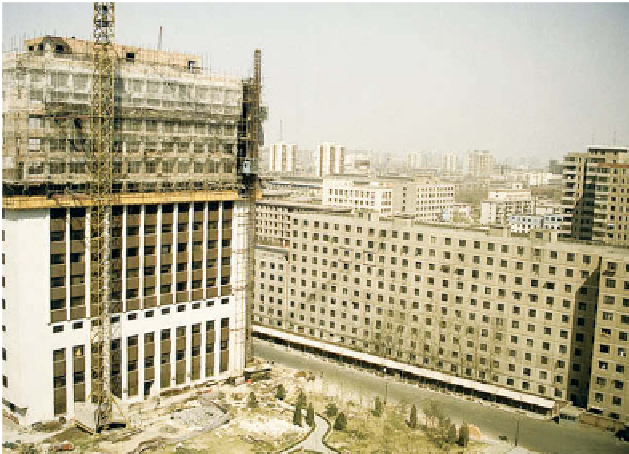Geography Reference
In-Depth Information
tile roofs on the outskirts of the expanding city must make
way for often faceless tenements (Fig. 12.13). Decaying
remnants of the old city stand amid the glass-encased tow-
ers that symbolize the new economic order. Modern sky-
scrapers now dominate the skyline of the cities at the top
of the Chinese urban-economic and administrative hierar-
chy—including Beijing, Shanghai, and cities in SEZs.
China's major cities now play host to gleaming new air-
ports, daring architecture, spectacular public projects, and
the terminuses of effi cient high speed railroads.
At the same time, the Northeast has become China's
“Rust Belt.” Many of its state-run factories have been sold
or closed, or are operating below capacity. Unemployment
is high, and economic growth has stalled. Eventually, the
Northeast is likely to recover because of its resources and
its favorable geographic site, but under the state's new
economic policies, the dynamic eastern and southern
provinces have grown into major manufacturing belts and
have changed the map of this part of the Pacifi c Rim.
Today, the Chinese government is pushing industri-
alization into the interior of the country, with new invest-
ment fl owing into poorer parts of the central and western
portions of the country. China is also looking to take
advantage of its proximity to South and Southeast Asia
through efforts to deepen transnational economic coop-
eration. From a global perspective, what is particularly
striking is the magnitude and infl uence of the Chinese
economic juggernaut. On August 15, 2010, China offi -
cially surpassed Japan as the world's second largest econ-
omy. China has become the world's largest exporter, and
its energy and raw materials demands are now affecting
the global supply of key resources. Today more passenger
vehicles are purchased in China each year than in the
United States, and China invests more domestically than
any other country in the world.
None of the foregoing means that China will inevi-
tably become the dominant power of the twenty-fi rst cen-
tury. China's economy still depends heavily on exports and
foreign investment, and China's GDP per capita, while on
the rise, is 10 times smaller than Japan's and 12.5 times
smaller than that of the United States. Moreover, there
are potentially destabilizing social and environmental
costs to China's rapid rise, and with labor costs growing in
China relative to Southeast Asia, China could be vulnera-
ble to some of the very forces that gave it an advantage
over other places not long ago.
Field Note
“Beijing, Shanghai, and other Chinese cities are being trans-
formed as the old is swept away in favor of the new. Locals,
powerless to stop the process, complain that their neigh-
borhoods are being destroyed and that their relocation to
remote apartment complexes is a hardship. Urban planners
argue that the 'historic' neighborhoods are often dilapi-
dated, decaying, and beyond renovation. The housing shown
in Figure 12.13 (top) was demolished to make room for what
is going up in Figure 12.13 (bottom), a scene repeated count-
less times throughout urbanizing China.”
Figure 12.13 top
Beijing, China.
© H. J. de Blij.
The Wider World
Other newly industrializing countries have become
increasingly signifi cant global nodes of production. Over
the past decade manufacturing has surged in South and
Southeast Asia, in South Africa, and in parts of Central
and South America. Brazil, Russia, India, China, and
South Africa are increasingly grouped under the acronym
Figure 12.13 bottom
Beijing, China.
© H. J. de Blij.












































